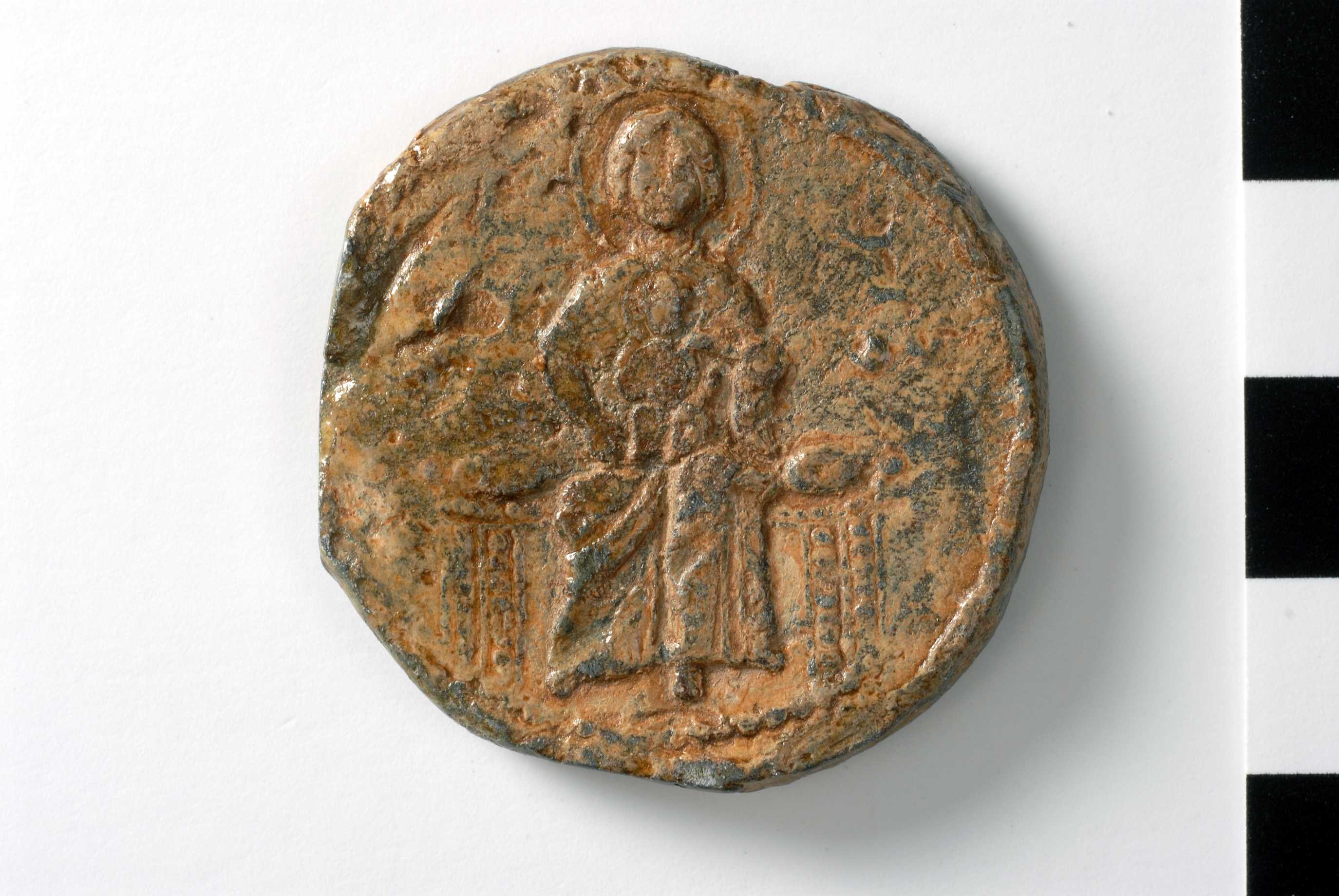Eustratios Garidas, patriarch of Constantinople (1081–84)
Obverse
The Mother of God, seated on a backless throne, holding Christ on her knees. At left and right, sigla ..-ΘV: [Μ(ήτη)ρ] Θ(εο)ῦ. Border of dots.
Obverse
The Mother of God, seated on a backless throne, holding Christ on her knees. At left and right, sigla ..-ΘV: [Μ(ήτη)ρ] Θ(εο)ῦ. Border of dots.
Reverse
Inscription of nine lines. Border of dots.
ΕΥ
ΣΤΡΑΤΙΟΣ
ΕΛΕΘΥΑΡΧ
ΕΠΙΣΚΟΠ..
ΚΝΣΤΑΝΤΙ..
ΠΟΛΕΣΝΕΑ
ΡΜΗΣΚΑΙΟ.
ΚΟΥΜΕΝΙΚ
ΠΡΙΑΡΧ
Εὐστράτιος ἐλέῳ Θ(εο)ῦ ἀρχ(ι)επίσκοπ[ος] Κωνσταντι[νου]πόλεως Νέα[ς] Ῥώμης καὶ ο[ἰ]κουμενικ(ὸς) π(ατ)ριάρχ(ης).
| Accession number | BZS.1955.1.4953 (formerly DO 55.1.4953) |
|---|---|
| Diameter | 36.0 mm |
| Previous Editions | DO Seals 6, no. 120.1; Zacos, Seals 2: 19b; Oikonomides, Dated Lead Seals, no. 100; and Laurent, Corpus 5.1: no. 20. Laurent refers to a similar seal (different boulloterion) published by Ébersolt, Sceaux, pl. VIII, no. 10 (reproduced in Galavaris, “Thokos,” pl. 54), but the specimen that Laurent illustrates on pl. 3 is that of Dumbarton Oaks. A parallel specimen, found in the area of the law courts of Mytilene, has been published by V. Pennas, “Byzantine Lead Seals from Chios and Lesbos,” SBS 2 (1990): 168, no. 2. Another parallel specimen, this one found in Kiev (northwest tower, St. Sophia cathedral), has recently been republished in Bulgakova, Osteuropa, no. 1.3.2 (with older bibliography). Cf. Galavaris, “Thokos,”, no. 23 (p. 175). |
Translation
Εὐστράτιος ἐλέῳ Θεοῦ ἀρχιεπίσκοπος Κωνσταντινουπόλεως Νέας Ῥώμης καὶ οἰκουμενικὸς πατριάρχης.
Eustratios, by the grace of God, archbishop of Constantinople, the New Rome, and ecumenical patriarch.
Bibliography
- Catalogue of Byzantine Seals at Dumbarton Oaks and in the Fogg Museum of Art, Vol. 6, Emperors, Patriarchs of Constantinople, Addenda (Open in Zotero)
- Byzantine Lead Seals, Vol. 2 (Open in Zotero)
- A Collection of Dated Byzantine Lead Seals (Open in Zotero)
- Le Corpus des sceaux de l’empire byzantin (Open in Zotero)
- The Representation of the Virgin and Child on a ‘Thokos’ on Seals of the Constantinopolitan Patriarchs (Open in Zotero)
- Pouvoir et contestations à Byzance, 963–1210 (Open in Zotero)
- Le Corpus des sceaux de l’empire byzantin (Open in Zotero)
- Les personnages byzantins de l’Alexiade: Analyse prosopographique et synthèse (Open in Zotero)

Commentary
The Garidai had already risen to prominence by the beginning of the tenth century: see Cheynet, Pouvoir, 363, n. 26. In the eleventh century, the family produced a jurist, who was appointed professor of law at the school that Constantine Monomachos founded in 1047. In the second half of the century it could claim a skribas named Constantine and in 1081 a patriarch. It is unknown if Eustratios was a member of the civil administration prior to his elevation. We know only that at that moment he was a monk and eunuch and enjoyed the patronage of Anna Dalassena, who played an active role in pressuring Kosmas to abdicate. See Laurent, Corpus 2: no. 1198. He is remembered for yielding to the pleas of Isaakios the sebastokrator that the gold and silver plate and ornaments of icons be melted down for coin to help protect the Empire, and for convoking a synod that condemned John Italos. Eustratios in turn was obliged to abdicate, retiring to the monastery of the Rouphinianai. See Skoulatos, Personnages, 87–88.